

Having misaligned teeth can really detract from a sophisticated, attractive smile. However, many adults don’t consider braces because they simply do not want to wear metal brackets and wires for two or more years. Dr. David Salibian understands this concern, which is why he is pleased to offer Invisalign in our Belmont, MA office. This treatment is just one of many options in cosmetic dentistry that can be found at EyeSmile Optometry & Dental Care of Belmont.
The Invisalign system consists of a set of clear, removable aligners that fit comfortably in the mouth and place gentle pressure on different areas of the bite to gradually reposition teeth. Because the trays are made out of high-quality clear plastic, most people won’t notice you’re wearing clear braces. You are able to remove the aligners for limited special occasions, to clean your teeth, and when you eat. Most patients complete the Invisalign treatment in 12 to 18 months – usually less time than traditional orthodontic treatment.
Because the treatment can usually correct the same issues that are treatable with conventional braces, many patients are eligible candidates for Invisalign. The most common orthodontic issues are treatable with clear braces, but more significant misalignments may still require treatment with conventional braces.
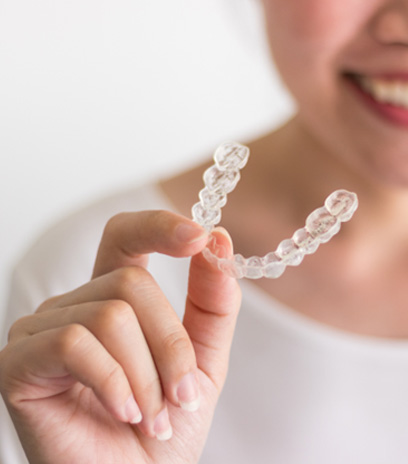
From misaligned teeth to bite problems, Invisalign can potentially be used to treat all kinds of orthodontic concerns. When you visit our office to discuss your candidacy for Invisalign, our team will thoroughly examine your mouth in order to learn as much as possible about the changes that need to be made. Below is a brief overview of some of the issues that can be corrected with customized clear aligners.
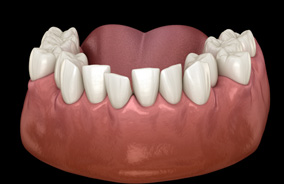
It can be very difficult to clean teeth that are crowded too closely together, which can lead to gum disease, cavities, and other oral health issues in the long run. And of course, crowded teeth can have a less-than-positive impact on the appearance of your smile. Invisalign can often be used to correct the positions of crowded teeth so that they are correctly aligned with each other.
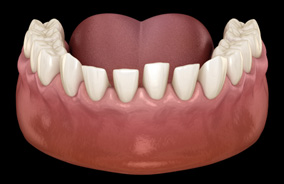
Overly large gaps between the teeth can be a bigger problem than you might think, as they provide areas where harmful bacteria and bits of food can easily accumulate. It’s therefore in your best interest to have these spaces closed as soon as possible, and Invisalign can be an effective way to do so.
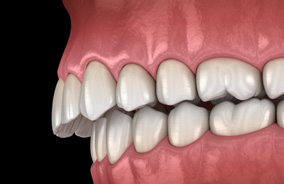
Do your upper teeth stick out too far in front of your lower teeth? This is known as an overbite, and it can lead to all kinds of problems. In particular, it can make it more difficult to chew properly, and it can put uneven pressure on your teeth, causing them to wear down faster. If your overbite is pronounced enough to be a problem, it may be possible to treat the issue with Invisalign.
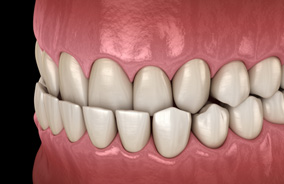
As you can probably guess, an underbite is the opposite of an overbite; it occurs when the lower teeth are too far in front of the upper teeth. Not only can an underbite have a negative impact on your ability to speak, but it can also potentially lead to mouth breathing or even sleep apnea. We may be able to correct your underbite with Invisalign depending on how severe it is.
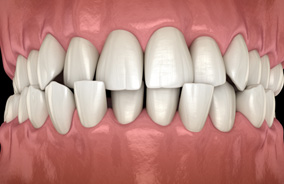
Having a crossbite means that some of the upper teeth are seated behind the lower teeth. A crossbite can result in an asymmetrical smile, and it can lead to jaw pain, headaches, and excessive tooth wear. A crossbite can sometimes be treated with Invisalign, but other services may be required depending on the underlying cause of the issue.
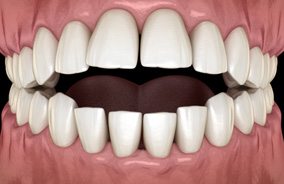
Your upper and lower teeth should come in contact with each other whenever you bite down; if they don’t, you have what is known as an open bite. This particular bite issue can put you at a higher risk for a chipped tooth, and it can lead to other complications such as difficulty chewing. We can evaluate your open bite to determine whether it can be successfully treated with Invisalign.
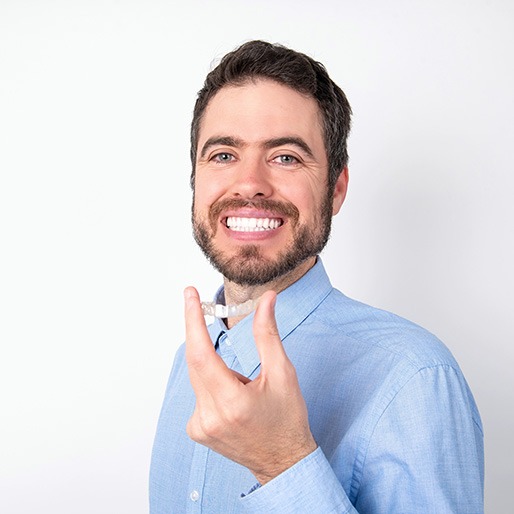
Many teens and adults will tell you that they prefer Invisalign over traditional braces. This is due to the many unique advantages that come with removable, fully personalized clear aligners. Are you still trying to figure out the best way to straighten your smile? To help make your decision a little easier, here is a closer look at some of the key benefits of Invisalign.

Are you worried about your orthodontic appliance drawing the wrong kind of attention to your smile while you’re at school or work? That won’t be an issue with Invisalign. Thanks to the material they’re made of, the aligners will be virtually invisible when worn. As a result, they won’t have a negative impact on your everyday appearance, meaning you can show off your smile with confidence throughout every step of your treatment.

One of the drawbacks of metal wires and brackets is that they can cause irritation when they rub against the inside of your cheeks, your gums, or your lips. Fortunately, Invisalign offers a much more comfortable alternative. Each aligner is made from smooth, low-profile plastic, so they’re less likely to irritate your soft tissues.

Since Invisalign aligners can be taken out of your mouth at any time, they offer a lot more flexibility than traditional braces. For one thing, you will have the freedom to enjoy all of your favorite foods without restriction throughout the orthodontic process. Additionally, you won’t have to worry about learning a complicated new oral hygiene routine; you will be able to brush and floss your teeth the same way you normally would.

Keeping your Invisalign clear aligners in excellent condition is easier than you might think. All you need to do is brush them thoroughly with a soft-bristled toothbrush and clear soap. Since the aligners are removable, you shouldn’t have any trouble cleaning every surface. Once you’re done brushing, all you need to do is rinse your aligners off in lukewarm water before putting them back inside your mouth.

Both traditional braces and Invisalign require periodic progress appointments. However, unlike traditional braces, Invisalign doesn’t need to be adjusted. As such, patients with clear aligners can typically expect their appointments to be completed in less time. During these visits, our team will make sure that your teeth are moving as expected, and we’ll provide you with the next set of aligners.

You’ve probably heard how traditional braces often need to be worn for two years or more. In comparison, the timeline for Invisalign is typically shorter, with the average treatment taking around 12 to 18 months. Of course, the type of malocclusion you have and the overall complexity of your case will determine how long you can expect your orthodontic treatment to take.

One of the questions we’ll need to answer during your initial Invisalign consultation is, “How much is the treatment expected to cost?” The amount you pay depends on quite a few factors, which is why we’ll need to examine your mouth first. Rest assured that our team will always take the time to fully explain the costs involved, and they’ll work with you to make the treatment as affordable as possible.

No two patients have the same dental needs. As such, the final cost of Invisalign will vary based on various factors such as:

The cost for Invisalign is usually between $3,000 and $8,000. Meanwhile, Smile Direct Club™, a DIY option for clear aligners, typically costs around $2,000. However, this is balanced out by a few important factors:

The answer depends on what insurance plan you have. Some policies offer a once-in-a-lifetime provision for orthodontic treatment that includes Invisalign. You should confirm your benefits before you begin any kind of orthodontic treatment. Our team has experience working with various dental plans, so we’ll be happy to answer any questions you might have about your coverage and whether Invisalign is included.

We accept many popular insurance plans like Delta Dental and MetLife. But if you don’t have insurance, don’t worry! You still have other options for fitting Invisalign into your budget:

Many older teens and adults are hesitant to undergo orthodontic treatment because they want to avoid dealing with metal wires and brackets. Fortunately, Invisalign allows you to discreetly and comfortably achieve a straighter smile in record time. Since the process is unique, it’s normal to have a few concerns before committing to it. To help you out, our team at EyeSmile Optometry & Dental Care of Belmont has decided to answer some frequently asked questions below. If you don’t see your specific question, feel free to reach out!
It depends! Generally, it takes about 12 to 18 months to complete Invisalign treatment. Of course, factors like the severity of your dental misalignment and your commitment to the treatment plan will affect the exact amount of time it takes. You can speed up the process by staying on track with your Invisalign treatment plan and visiting our team regularly to ensure everything is moving accordingly.
The smooth plastic design of Invisalign’s clear aligners makes it one of the most comfortable orthodontic treatment options available today. Although treatment is not painful, there is an adjustment period you have to go through. When you first get your aligners, you’ll likely experience mild soreness and discomfort that some may characterize as pain. However, it should go away once you get used to your treatment. The plastic trays apply gentle pressure to move a portion of your smile at a time until the entire thing is aligned. Because of that, you might also experience pressure every time you advance to the next set of aligners. You can manage your discomfort by taking over-the-counter pain medication as needed, using cold compresses, or drinking ice cold water.
At your last orthodontist appointment, we’ll examine your teeth to ensure they’re in their final desired, straight position. Once we’re satisfied with your results, we’ll explain how to maintain your newly aligned smile. You’ll need to wear a retainer post-treatment to preserve your hard-earned results. After examining your case, we’ll recommend how often you’ll need to wear your oral appliance. Typically, patients start wearing it full-time before gradually decreasing to only wearing it at night.
Since Invisalign is removable, there are no dietary restrictions while you undergo treatment. However, you need to make sure you remove your aligners before eating or drinking anything that’s not water. If you fail to do so, you can damage your plastic trays by causing cracks or stains. Eating with your aligners also puts unnecessary pressure on your teeth. That’s why you should take them out before every meal and snack. Don’t forget to store them in a safe place when they’re not in your mouth!
I Need a Checkup & Cleaning I Need a Dentist for My Child I am Worried about Bleeding Gums I am Concerned about Sleep Apnea I Have a Cavity or Broken Tooth I am Missing One or More Teeth I am Unhappy with My Smile I am Scared of the Dentist I am in Pain & Need Help View Our Dental Services View Our Optometry Services